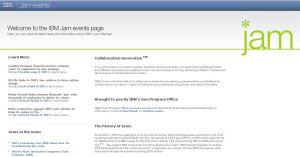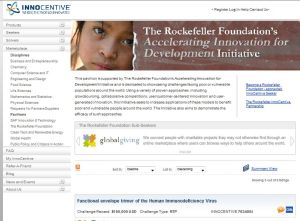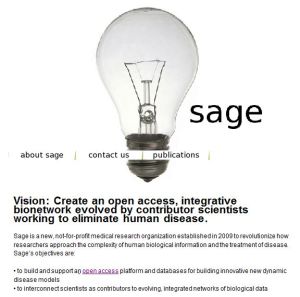The stereotype goes that we live in an age of blurring lines.
But sometimes there is merit in stereotypes and a recent e-debate on e-participation organized by the Pep-Net network reminded me of this fact. In one of those threads we discussed what the private and public sectors can learn from one another. Well, a lot it seems. But most of all, the importance of innovation I think; by opening-up, by embracing and experimenting with crowdsourcing ideas and mostly through persistent cultivation of a new more daring mentality. Some are already walking down this one-way street and they will be positioned to reap significant benefits in the future – a few are enjoying these in the present. Let me cite three examples that may hopefully inspire you:
1. Spread the Jam: IBM’s Collaborative Innovation model
IBM, which used to be the embodiment of a huge, “grey”, inertia-stricken conglomerate, has done great strides and has embraced knowledge management in a big way. In this way, it fosters creativity within the organization but one of their most impressive undertakings is none other than the IBM Jam Events, an example of their Collaborative Innovation model. Here is how IBM describes the concept of Collaborative Innovation:
“In a world where innovation is global, multidisciplinary and open, you need to bring different minds and different perspectives together to discover new solutions to long-standing problems. Therein lies the essence of collaborative innovation.”
Inspired by James Surowiecki’s “The Wisdom of Crowds” and Jeff Howe’s “Crowdsourcing” ideas, IBM subscribed to the belief that public discussion of research ideas could solve problems faster than IBM’s own researchers tackling them secretly. There came the “Innovation Jams”, where the company’s researchers, employees and outside experts are invited to join in virtual brainstorming sessions. They post their ideas for innovations and then others join in, commenting on the posts and voting for their favorites.
“ValuesJam in 2003 gave IBM’s workforce the opportunity to redefine the core IBM values for the first time in nearly 100 years. During IBM’s 2006 Innovation Jam- the largest IBM online brainstorming session ever held – IBM brought together more than 150,000 people from 104 countries and 67 companies.”
The Bottom-line: Jams started in 2001 and by 2006, 46,000 ideas were produced, the company invested more than $100 million in seed ideas and created 10 new divisions to follow up on those.
Now, what can the public sector learn? This is what IBM suggests:
“Jams are not restricted to business. Their methods, tools and technology can also be applied to social issues. In 2005, over three days, the Government of Canada, UN-HABITAT and IBM hosted Habitat Jam. Tens of thousands of participants – from urban specialists, to government leaders, to residents from cities around the world – discussed issues of urban sustainability. Their ideas shaped the agenda for the UN World Urban Forum, held in June 2006. People from 158 countries registered for the jam and shared their ideas for action to improve the environment, health, safety and quality of life in the world’s burgeoning cities.”
Naturally, most public officials and corporate leaders will shudder at the thought of disrupting the long-established hierarchical and rigid structures. Adam Christensen –Social Media Manager at IBM- offers a few insights on this process in a short presentation found here. His main points and suggestions are: Cultivate a bottom-up culture change, trust and empower employees (“after all they are the brand”), don’t be afraid of failure and, experiment-experiment-experiment.
[Links: IBM Jam Events, IBM Innovation Jam 2008, IBM Social Network to advance SOA, VentureBeat on Jam 08, Global Dialogue Center-Habitat Jam, check also Luis Suarez’s KM blog]
2. Innocentive: A market place for innovation
The idea is simple: You have a problem-any problem. You post it and you let anyone offer solutions. You pay for the best one. In other words, as New York Times puts it: If You Have a Problem, Ask Everyone. In “Innocentive-speak”:
- If you have a problem (called “Challenge”), you are a “Seeker”.
- If you have a solution to suggest, you are a “Solver”.
- You connect online in the Open Innovation Marketplace : Seeker & solver identities are kept completely confidential and secure, InnoCentive managing the entire IP process.
“Solvers” who deliver the most innovative solutions receive financial awards ranging up to US$1,000,000 and “Seekers” include commercial, government and non-profit organizations such as Procter & Gamble, Avery Dennison, Pendulum, Eli Lilly and Company, Janssen, Solvay, GlobalGiving etc.
The company was founded in 2000 as an in-house innovation “incubator” for the Elli Lilly pharma company and gone independent in 2005. Initially it focused in life sciences, pharmaceutical, biology etc but now this marketplace connects companies, academic institutions, public sector and non-profit organizations, with a global network of more than 170,000 of the world’s brightest minds, in more than 175 countries. One of the recent “Challenges” is how to improve the US health-care system.
As they describe it, the system provides a flexible tool-set to be used anywhere in the organization. Considering that Innocentive is often seen as a last resort for organizations that cannot find a solution otherwise (meaning internally), an impressive 40% of problem-challenges posted are solved.
Innocentive believes that if organizations overcome their initial fears -these essentially being “what do they pay me for, if I cannot solve the problem” – and integrate it organically within their strategy, it may well become a “first resort” solution in the quest for innovative solutions.
Exploiting Innocentive for non-profit purposes seems to be an even more successful endeavour and “The Rockefeller Foundation“ knows that very well. They went into partnership with Innocentive and created the “Accelerating Innovation for Development Initiative”, dedicated to showcasing challenges facing poor or vulnerable populations around the world. Through the partnership, the foundation explores novel and proven approaches, including crowdsourcing, collaborative competitions, user/customer-centered innovation and user-generated innovation. “Reducing Risk of Malaria with Solar Powered Device” and “Solar-powered wireless routers” are two examples of solved problems.
By the way, Gary Hamel – who has been called “the world’s most influential business thinker” by The Wall Street Journal – was recently appointed to the InnoCentive Strategic Advisory Board.
[Links: New York Times, Business Week Podcast, Corporate blog, Innoblogger, Facebook Page, Twitter]
3. SAGE: On track to create the “Google of biology”
One of the most secretive, introverted, patent-based industries in the world, the pharmaceutical industry, is now having a new treatment from Stephen Friend, a cancer research guru and Merck’s former senior vice-president of cancer research. Friend – who believes that Cancer drugs don’t help 75% of the people who take them – seems that has secured $5 million in donations to kick-start a new non-profit organization in Seattle called Sage.
Sage’s vision is to “Create an open access, integrative bionetwork evolved by contributor scientists working to eliminate human disease” and for this purpose it aims:
- to build and support an open access platform and databases for building innovative new dynamic disease models
- to interconnect scientists as contributors to evolving, integrated networks of biological data
Possibly oversimplifying here, physicians could look at genetic profiles from their patients, match it up with the Sage free open database – which will contain anonymous genomic profiles collected from scientists around the world – and then prescribe the medicine most likely to work. In other words, get all of the data to talk to each other (sounds like Tim Berners-Lee’s Linked Open Data project?) for the benefit of all: The FDA, health insurers and drug companies, providing better insights and potentially save years of wasted efforts and millions of dollars.
Significantly enough, in order for Sage to gain insights from the open-source model in the computing world, John Wilbanks, the vice president of science at Creative Commons is joining the Board.
Sage’s co-founder Eric Schadt says: “We see this becoming like the Google of biological science. It will be such an informative platform, you won’t be able to make decisions without it. We want this to be like the Internet. Nobody owns it.”
[Links: SAGE, Open Access Overview, Bio-IT World, Forbes, Xconomy Seattle]
Now you have a choice: Innovate or Perish
The moral of the story is all too clear for business. What about politics? If private enterprises and conglomerates with a single-minded profit mandate dare to innovate by “opening up” and engaging into a conversation with their employees and stakeholders, there must be something rotten with political parties and governments whose mandate is to represent citizens’ voices but resist even the simplest act of listening, let alone engage into a meaningful conversation and exploit the wealth of human intelligence.
Unless of course there is a “grand plan” which says that their constituents will eventually diminish so much that they will no longer need the web to discuss…they will simply invite them home for coffee.















